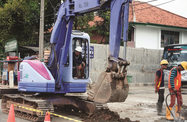 On addressing the infrastructure deficit in emerging Asia
On addressing the infrastructure deficit in emerging Asia
How do you see the newly formed Infrastructure Asia dovetailing with transnational initiatives like the Belt and Road?
SETH TAN KENG HWEE: I think the Belt and Road Initiative identifies a very large need when it comes to infrastructure. The market really needs infrastructure, but I think our cooperation would have to be case-specific. We want to enable good fit solutions from Singapore that meet the needs of local governments, so there could be certain situations where it makes sense to collaborate. For example, in many Asian countries, we find that projects may no longer be owned by one company; rather, local counterparts may wish to have some percentage of ownership. In these instances, the local counterpart from an Asian country is very familiar with Singapore-based companies and they may have a choice of Singapore-based companies that provide one aspect of the service. In such cases, a partnership would make a lot of sense.
How can low- and middle-income Asian countries participate in major infrastructure initiatives without assuming unsustainable debt burdens?
SETH: Participating in major infrastructure initiatives can have a variety of outcomes due to the substantial financing needs. Infrastructure Asia plays an interesting role because Singapore is perceived by many Asian governments as neutral and, additionally, we share fairly similar development experiences with a lot of Asian counterparts. Given the above, as well as our strong connectivity and familiarity of the region, Singapore is well placed to support regional infrastructure development. From that perspective, I think our role is, first and foremost, to focus on appropriate solutions for making projects bankable. Projects should not be overly burdensome from a debt perspective, because the outcome should create positive long-term economic benefits. It is only when the project is not bankable or investible, but is undertaken anyway, that debt burdens become an issue.
In what ways can ASEAN members channel the region’s relatively high domestic savings into infrastructure investments to mitigate foreign currency risks?
SETH: If you look purely at the quantum of savings of Asia in relation to the demand for investment in infrastructure, there is actually enough money to meet the demand. Part of the reason it is not channelled into infrastructure currently is that the projects are not bankable or they do not fit the needs and expectations of investors. One solution could be to tweak the project structure. Otherwise, investors will opt for lower-risk assets that better fit their risk profiles. They could be investing in bonds in OECD countries rather than putting money into Asia, which is currently the tendency.
In order to encourage investments into Asian infrastructure, I think we must collaboratively play a part in making some of these projects more bankable. If we can make processes easier, it will attract more sources of capital. For example, the recently launched Singapore Infrastructure Dispute-Management Protocol is a case-specific dispute resolution mechanism. This mechanism is built to prevent a project’s early issues from mounting into unsolvable problems, thereby requiring lengthy and costly arbitration. That said, if complex projects are completed on time and on budget, more players will look towards long-term investment opportunities.
Project preparation is another key area to address. Singapore has been talking about standardisation of contracts. This will help attract more varieties of capital, such as infrastructure funds, because they cannot afford to wait two or three years while we negotiate the contract for a project, as they have to deploy their capital. If we can standardise 70-80% of contracts, bearing in mind that 20-30% would be case-specific, then I think it saves a lot of time in terms of project preparation. All of a sudden you may have a new runway of capital sources willing to look at a project.
To what extent does the launch of the ASEAN Green Bond Standards pave the way for more sustainable green financing of infrastructure projects in the region?
SETH: Initiatives like this help, because investors want to invest in instruments that will be recognised in a positive way. Many investors, either voluntarily or through regulation, are getting more involved in green initiatives – whether they build projects that are green and sustainable or that can adapt to climate change, or they invest in instruments like green bonds. Standardisation creates more visibility and more recognition for the product. At the end of the day, if the ASEAN Green Bond becomes a benchmark for such issuances, like Standard & Poor’s or Moody’s in the credit rating world, then more parties may use these standards.

 On addressing the infrastructure deficit in emerging Asia
On addressing the infrastructure deficit in emerging Asia